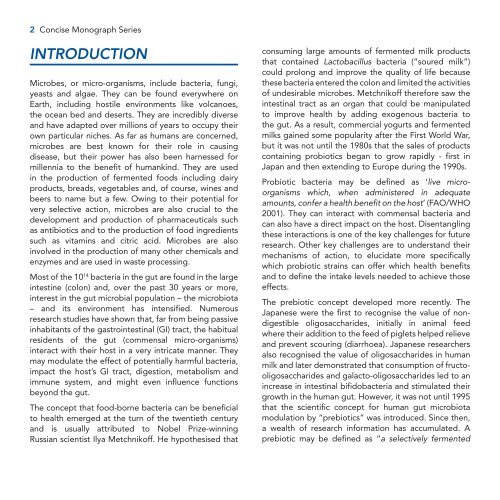probiotics, prebiotics and the gut microbiota - International Life ...
probiotics, prebiotics and the gut microbiota - International Life ...
probiotics, prebiotics and the gut microbiota - International Life ...
You also want an ePaper? Increase the reach of your titles
YUMPU automatically turns print PDFs into web optimized ePapers that Google loves.
2 Concise Monograph SeriesINTRODUCTIONMicrobes, or micro-organisms, include bacteria, fungi,yeasts <strong>and</strong> algae. They can be found everywhere onEarth, including hostile environments like volcanoes,<strong>the</strong> ocean bed <strong>and</strong> deserts. They are incredibly diverse<strong>and</strong> have adapted over millions of years to occupy <strong>the</strong>irown particular niches. As far as humans are concerned,microbes are best known for <strong>the</strong>ir role in causingdisease, but <strong>the</strong>ir power has also been harnessed formillennia to <strong>the</strong> benefit of humankind. They are usedin <strong>the</strong> production of fermented foods including dairyproducts, breads, vegetables <strong>and</strong>, of course, wines <strong>and</strong>beers to name but a few. Owing to <strong>the</strong>ir potential forvery selective action, microbes are also crucial to <strong>the</strong>development <strong>and</strong> production of pharmaceuticals suchas antibiotics <strong>and</strong> to <strong>the</strong> production of food ingredientssuch as vitamins <strong>and</strong> citric acid. Microbes are alsoinvolved in <strong>the</strong> production of many o<strong>the</strong>r chemicals <strong>and</strong>enzymes <strong>and</strong> are used in waste processing.Most of <strong>the</strong> 10 14 bacteria in <strong>the</strong> <strong>gut</strong> are found in <strong>the</strong> largeintestine (colon) <strong>and</strong>, over <strong>the</strong> past 30 years or more,interest in <strong>the</strong> <strong>gut</strong> microbial population – <strong>the</strong> <strong>microbiota</strong>– <strong>and</strong> its environment has intensified. Numerousresearch studies have shown that, far from being passiveinhabitants of <strong>the</strong> gastrointestinal (GI) tract, <strong>the</strong> habitualresidents of <strong>the</strong> <strong>gut</strong> (commensal micro-organisms)interact with <strong>the</strong>ir host in a very intricate manner. Theymay modulate <strong>the</strong> effect of potentially harmful bacteria,impact <strong>the</strong> host’s GI tract, digestion, metabolism <strong>and</strong>immune system, <strong>and</strong> might even influence functionsbeyond <strong>the</strong> <strong>gut</strong>.The concept that food-borne bacteria can be beneficialto health emerged at <strong>the</strong> turn of <strong>the</strong> twentieth century<strong>and</strong> is usually attributed to Nobel Prize-winningRussian scientist Ilya Metchnikoff. He hypo<strong>the</strong>sised thatconsuming large amounts of fermented milk productsthat contained Lactobacillus bacteria (“soured milk”)could prolong <strong>and</strong> improve <strong>the</strong> quality of life because<strong>the</strong>se bacteria entered <strong>the</strong> colon <strong>and</strong> limited <strong>the</strong> activitiesof undesirable microbes. Metchnikoff <strong>the</strong>refore saw <strong>the</strong>intestinal tract as an organ that could be manipulatedto improve health by adding exogenous bacteria to<strong>the</strong> <strong>gut</strong>. As a result, commercial yogurts <strong>and</strong> fermentedmilks gained some popularity after <strong>the</strong> First World War,but it was not until <strong>the</strong> 1980s that <strong>the</strong> sales of productscontaining <strong>probiotics</strong> began to grow rapidly - first inJapan <strong>and</strong> <strong>the</strong>n extending to Europe during <strong>the</strong> 1990s.Probiotic bacteria may be defined as ‘live microorganismswhich, when administered in adequateamounts, confer a health benefit on <strong>the</strong> host’ (FAO/WHO2001). They can interact with commensal bacteria <strong>and</strong>can also have a direct impact on <strong>the</strong> host. Disentangling<strong>the</strong>se interactions is one of <strong>the</strong> key challenges for futureresearch. O<strong>the</strong>r key challenges are to underst<strong>and</strong> <strong>the</strong>irmechanisms of action, to elucidate more specificallywhich probiotic strains can offer which health benefits<strong>and</strong> to define <strong>the</strong> intake levels needed to achieve thoseeffects.The prebiotic concept developed more recently. TheJapanese were <strong>the</strong> first to recognise <strong>the</strong> value of nondigestibleoligosaccharides, initially in animal feedwhere <strong>the</strong>ir addition to <strong>the</strong> feed of piglets helped relieve<strong>and</strong> prevent scouring (diarrhoea). Japanese researchersalso recognised <strong>the</strong> value of oligosaccharides in humanmilk <strong>and</strong> later demonstrated that consumption of fructooligosaccharides<strong>and</strong> galacto-oligosaccharides led to anincrease in intestinal bifidobacteria <strong>and</strong> stimulated <strong>the</strong>irgrowth in <strong>the</strong> human <strong>gut</strong>. However, it was not until 1995that <strong>the</strong> scientific concept for human <strong>gut</strong> <strong>microbiota</strong>modulation by “<strong>prebiotics</strong>” was introduced. Since <strong>the</strong>n,a wealth of research information has accumulated. Aprebiotic may be defined as “a selectively fermented
















